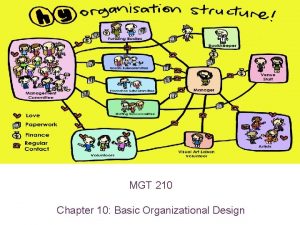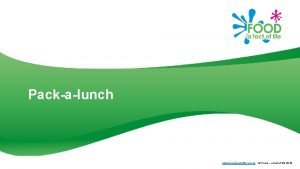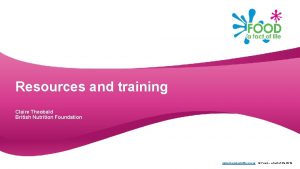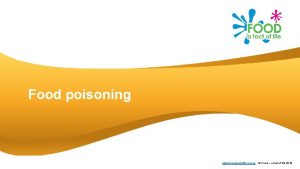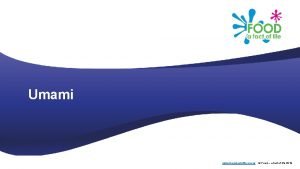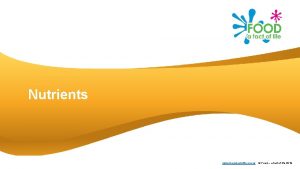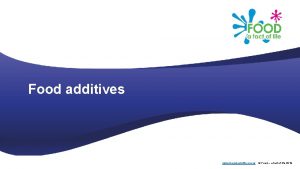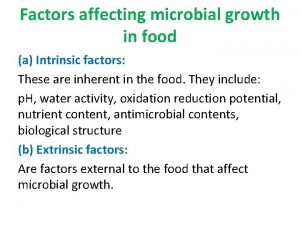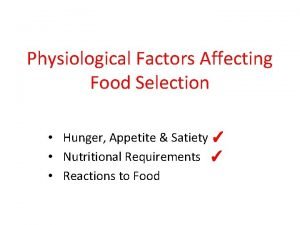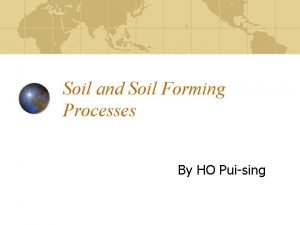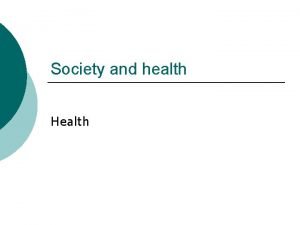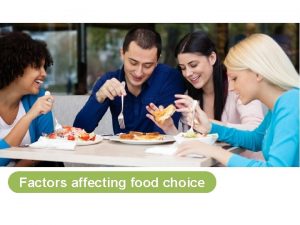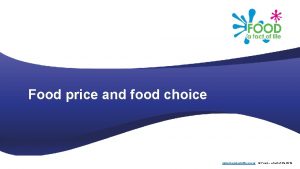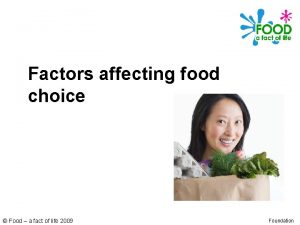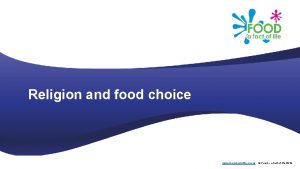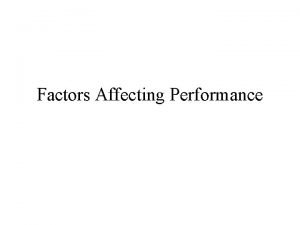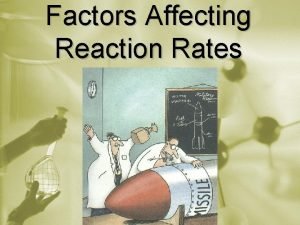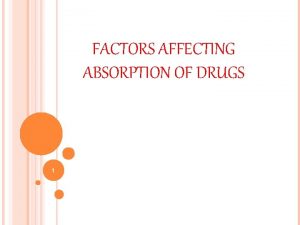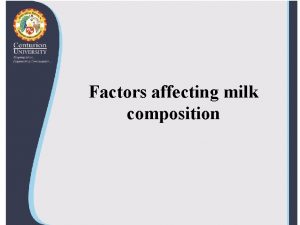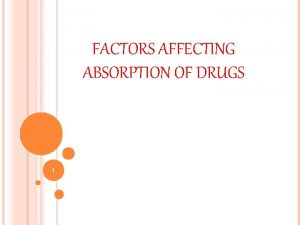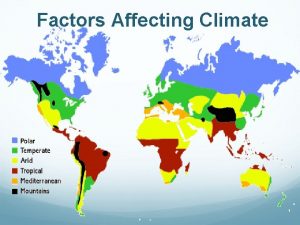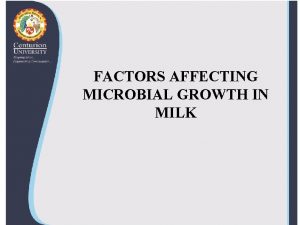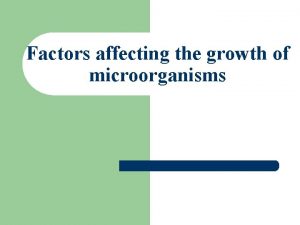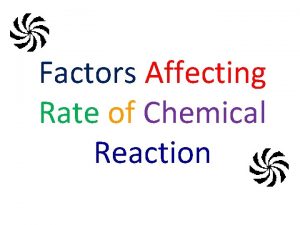Factors affecting food choice www foodafactoflife org uk

































- Slides: 33

Factors affecting food choice www. foodafactoflife. org. uk © Food – a fact of life 2019

Factors affecting food choice All around the world, people choose to eat different food for many different reasons, such as: • individual energy and nutrient needs; • diet and health; • religion and culture; • cost of food; • food availability. www. foodafactoflife. org. uk © Food – a fact of life 2019

Factors affecting food choice Different reasons for choosing food also include: • time of day and occasion; • food preferences; • social considerations; • environmental considerations; • advertising and other point of sale information. www. foodafactoflife. org. uk © Food – a fact of life 2019

Individual energy and nutrient needs The amount of energy and nutrients needed differs between age groups and between males and females. Energy needs also depend on activity levels. Athletes, for example, have much higher energy requirements as they are more physically active. www. foodafactoflife. org. uk © Food – a fact of life 2019

Diet and health People may choose the food they eat based on their own or their family’s health concerns or for medical reasons. This could include: • diabetes; • allergies, e. g. nuts; • intolerances, e. g. gluten (coeliac disease) or lactose; • vegetarian; • vegan; • weight loss or gain. Where would you find information about potential allergens in food? Why is this important? www. foodafactoflife. org. uk © Food – a fact of life 2019

Religion and culture Food is an important part of observance for many different religious beliefs and cultures. All over the world many people choose to eat or avoid certain foods according to their religious beliefs. www. foodafactoflife. org. uk © Food – a fact of life 2019

Religion and culture Religions and beliefs which have particular food restrictions or celebrations involving food include: • Christianity; • Islam; • Hinduism; • Judaism; • Sikhism; • Buddhism; • Seventh-day Adventist Church; • Rastafari Movement. www. foodafactoflife. org. uk © Food – a fact of life 2019

Cost of food The cost of food and money available will influence people’s food choices. If money is limited, people may choose to buy more basic items. Luxury items might then used for special occasions. Food prepared at home is often cheaper than eating out, buying take-aways or ready prepared food. www. foodafactoflife. org. uk © Food – a fact of life 2019

Food availability Most foods are grown in a particular season of the year, e. g. strawberries are harvested in summer. These are called ‘seasonal foods’. Buying foods when they are in season will often ensure the food price is lower. Technology and the importation of food, however, has allowed food to be available all year round. Frozen foods such as vegetables are a great alternative to fresh, if they are unavailable. www. foodafactoflife. org. uk © Food – a fact of life 2019

Time of day and occasion The time of day will influence food choice – people may not eat the same for breakfast as they would for their main meal of the day. The occasion will also impact on food choice – this could be a celebration such as a birthday or wedding or maybe a religious occasion such as Christmas or Passover. www. foodafactoflife. org. uk © Food – a fact of life 2019

Food preferences Not everyone likes the same food. The taste, odour, appearance, shape and colour of food can affect people in different ways. Which senses do we use when making our food choices? www. foodafactoflife. org. uk © Food – a fact of life 2019

Social and economic considerations Lack of competence and confidence in the kitchen – people may choose to buy ready made, frozen or dried foods that are easy to prepare and cook and that require only basic cooking skills. Lack of time – many people work long hours and either haven’t got the time or do not wish to spend time cooking at home. Source: ONS/Kantar Worldpanel Usage www. foodafactoflife. org. uk © Food – a fact of life 2019

Social and economic considerations Development of ready meals – because people lack time and have labour saving equipment (such as microwaves) the amount and range of convenience foods has grown. Smaller households – an increasing number of people now live alone and this may well affect their food choices. In 1960, 40% of households were 1 -2 people and in 2016, this had risen to 63%. By 2027, more than a third of the population will be over 60. Source: ONS/Kantar Worldpanel Usage www. foodafactoflife. org. uk © Food – a fact of life 2019

Social and economic considerations Eating out - Since 2013, eating out expenditure has risen by 9. 5 per cent. The average money spent on all food and drink eaten out is £ 13. 48 person per week. However, energy intake from eating out was 9. 6 per cent lower in 2015 than in 2012. Average energy intake from eating out was 240 kcal person per day in 2015 accounting for 11 per cent of total energy intake. Source: Family food survey www. foodafactoflife. org. uk © Food – a fact of life 2019

Social and economic considerations Body image and peer pressure can both influence the food that people choose to buy, cook and eat. A balanced diet, together with regular physical activity, can help to maintain a healthy weight. Eating the right balance of a wide range of foods provides most people with the energy and nutrients that they need to stay healthy. www. foodafactoflife. org. uk © Food – a fact of life 2019

Environmental and ethical considerations Human and animal welfare along with fair trading, scientific intervention in the food chain and the impact of food production on the environment can be of a high social concern for some people. Some considerations when buying food might be: • fair trading – ensuring that farmers in less economically developed countries get a fair deal; www. foodafactoflife. org. uk © Food – a fact of life 2019

Environmental and ethical considerations • local foods – buying locally supports local business and farmers and some believe that food produced locally is more sustainable; • seasonal food – this can be fresher, tastier and more nutritious than out of season food; • genetically modified (GM) food – scientific intervention is used to change a plant, animal or micro-organism’s genes or to insert one gene from another organism; www. foodafactoflife. org. uk © Food – a fact of life 2019

Environmental and ethical considerations • organic food – food sold as ‘organic’ must come from growers, processors and importers who are registered and approved by organic certification bodies, which are shown on the food label; • free range – animals are allowed to roam freely outside: this food may be more expensive; www. foodafactoflife. org. uk © Food – a fact of life 2019

Food provenance means where ingredients and the foods made from them originally come from. Many consumers want to know where their food originated. www. foodafactoflife. org. uk © Food – a fact of life 2019

Food provenance Protected Geographical Indication (PGI) Products which must be produced, processed or prepared within the geographical area and have a reputation, features or certain qualities attributable to that area. www. foodafactoflife. org. uk © Food – a fact of life 2019

Food provenance Protected Geographical Indication (PGI) Two British products with PGI are: • Welsh lamb – Welsh lamb is derived from the sheep breeds of Wales and lambs are raised extensively on grassland; • traditional Cumberland Sausage - is a spiral coil shaped seasoned pork sausage. Its most distinctive feature is that, unlike other sausages, it is not linked but long and coiled. www. foodafactoflife. org. uk © Food – a fact of life 2019

Food provenance Traditional Speciality Guaranteed (TSG) Products which are traditional or have customary names and have a set of features which distinguish them from other similar products. These features must not be due to the geographical area the product is produced in nor entirely based on technical advances in the method of production. www. foodafactoflife. org. uk © Food – a fact of life 2019

Food provenance Traditional Speciality Guaranteed (TSG) Two examples of British products with TSG are: • Gloucestershire Old Spots Pork - the first breed of any species in the world to be awarded TSG status; • Pembrokeshire earlies – Welsh potatoes that are harvested earlier than many other UK varieties, usually in the first week of May. www. foodafactoflife. org. uk © Food – a fact of life 2019

Food provenance Protected Designation of Origin (PDO) Products which are produced, processed and prepared within a particular geographical area and have a reputation, features or certain qualities attributable to that area. www. foodafactoflife. org. uk © Food – a fact of life 2019

Food provenance Protected Designation of Origin (PDO) Two examples of British products with PDO are: • Orkney beef – a feature of Orkney Beef farming is the widespread use of Aberdeen Angus and Shorthorn cross breeding cows which give the beef its distinctive characteristics; • Beacon Fell Traditional Lancashire cheese - made exclusively in the Preston area from local milk which is pasteurised. Cylindrical shaped cheese made from the curd of two or three days. The cheese is lightly pressed for 2 days, waxed or buttered or cloth bound and is fully mature at 6 months. www. foodafactoflife. org. uk © Food – a fact of life 2019

Food assurance schemes Red Tractor assurance standards cover food safety, animal welfare, environmental protection and traceability. The Red Tractor logo tells the consumer that the food has been checked every step of the way and can be traced back to the farm source. The Red Tractor logo appears on these products: • meat - beef, lamb, pork, chicken, turkey; • dairy - milk, cheese, cream; • cereals and flour; • fruit, vegetables and salads; • sugar. www. foodafactoflife. org. uk © Food – a fact of life 2019

Food assurance schemes The British Lion mark A quality code of practice that ensures eggs have been produced to the highest standards of food safety. The code covers the entire production chain and ensures strict food safety controls including the guarantee that all hens are vaccinated against Salmonella and a ‘passport’ system ensuring that all hens, eggs and feed are fully traceable. www. foodafactoflife. org. uk © Food – a fact of life 2019

Food assurance schemes Marine Stewardship Council The MSC is used to assess if a fishery is well managed and sustainable. The Standard has three core principles: • sustainable fish stocks; • minimising environmental impact; • effective fisheries management. The MSC logo can be used on fresh fish counters, packaged fish products and restaurant menus. www. foodafactoflife. org. uk © Food – a fact of life 2019

Advertising and other point of sale information Advertisements encouraging people to choose certain foods often appear in the media. Point of purchase information and product placement are strategies often used to provide information to consumers. www. foodafactoflife. org. uk © Food – a fact of life 2019

Other sources of information There are many sources of information to help people when making food choices: • Department of Health; • NHS Choices; • British Nutrition Foundation – www. nutrition. org. uk • supermarkets, food manufacturers, charities and other groups; • the media, i. e. internet, newspapers, radio, magazines and television programmes. It is important that advice is clear, consistent and correct. Look for the Information Standards logo. www. foodafactoflife. org. uk © Food – a fact of life 2019

Other sources of information Front and back of pack labels are also a good source of information to help make food choices. Information required on the labels of pre-packed food and drink products: • name of food or drink; • list of ingredients (including additives and allergens); • weight or volume; • date mark; www. foodafactoflife. org. uk © Food – a fact of life 2019

Other sources of information Information required on the labels of pre-packed food and drink products also includes: • storage and preparation conditions; • name and address of the manufacturer, packer or seller; • country of origin and place of provenance; • nutrition information. www. foodafactoflife. org. uk © Food – a fact of life 2019

Factors affecting food choice For further information, go to: www. foodafactoflife. org. uk © Food – a fact of life 2019
 Contingency factors affecting structural choice
Contingency factors affecting structural choice Functional strategy and strategic choice
Functional strategy and strategic choice Functional strategy and strategic choice
Functional strategy and strategic choice Intrathecal route advantages and disadvantages
Intrathecal route advantages and disadvantages Www.foodafactoflife.org.uk
Www.foodafactoflife.org.uk Bnf explore food
Bnf explore food Foodafactoflife
Foodafactoflife Food a fact of life
Food a fact of life Food a fact of life
Food a fact of life Www.foodafactoflife.org.uk
Www.foodafactoflife.org.uk Www.foodafactoflife.org.uk
Www.foodafactoflife.org.uk Www.foodafactoflife.org.uk
Www.foodafactoflife.org.uk Www.foodafactoflife.org.uk
Www.foodafactoflife.org.uk Factors affecting microbial growth in food
Factors affecting microbial growth in food Intrinsic factors affecting the growth of microorganisms
Intrinsic factors affecting the growth of microorganisms What factors influence satiety?
What factors influence satiety? Bacterial growth curve
Bacterial growth curve Good choice or bad choice
Good choice or bad choice Unit 2 food food food
Unit 2 food food food Food chain sequence
Food chain sequence What are the factors affecting the climate
What are the factors affecting the climate Types of volcanoes
Types of volcanoes Factors affecting volcanic eruption
Factors affecting volcanic eruption When does the simple carburetor supplies rich mixture
When does the simple carburetor supplies rich mixture Differential thermal analysis
Differential thermal analysis Factors that affect housing choices
Factors that affect housing choices Factors of bilingualism
Factors of bilingualism Human movement impact factor
Human movement impact factor Stroke volume normal
Stroke volume normal Factors affecting movement in physical education
Factors affecting movement in physical education Baricity of local anesthetics
Baricity of local anesthetics Eluviation and illuviation
Eluviation and illuviation Factors affecting health
Factors affecting health Explain the factors affecting chemical equilibrium
Explain the factors affecting chemical equilibrium
